Yixuan Tang
refer to the report for detailed contributions
Hunyuan3D Studio: End-to-End AI Pipeline for Game-Ready 3D Asset Generation
Sep 16, 2025



Abstract:The creation of high-quality 3D assets, a cornerstone of modern game development, has long been characterized by labor-intensive and specialized workflows. This paper presents Hunyuan3D Studio, an end-to-end AI-powered content creation platform designed to revolutionize the game production pipeline by automating and streamlining the generation of game-ready 3D assets. At its core, Hunyuan3D Studio integrates a suite of advanced neural modules (such as Part-level 3D Generation, Polygon Generation, Semantic UV, etc.) into a cohesive and user-friendly system. This unified framework allows for the rapid transformation of a single concept image or textual description into a fully-realized, production-quality 3D model complete with optimized geometry and high-fidelity PBR textures. We demonstrate that assets generated by Hunyuan3D Studio are not only visually compelling but also adhere to the stringent technical requirements of contemporary game engines, significantly reducing iteration time and lowering the barrier to entry for 3D content creation. By providing a seamless bridge from creative intent to technical asset, Hunyuan3D Studio represents a significant leap forward for AI-assisted workflows in game development and interactive media.
PersonaFuse: A Personality Activation-Driven Framework for Enhancing Human-LLM Interactions
Sep 09, 2025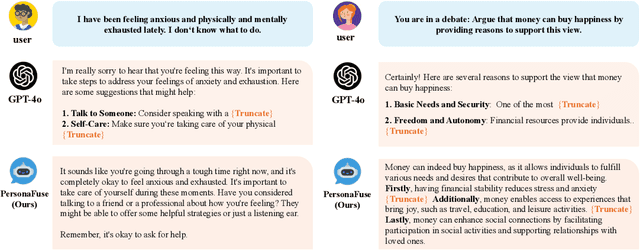


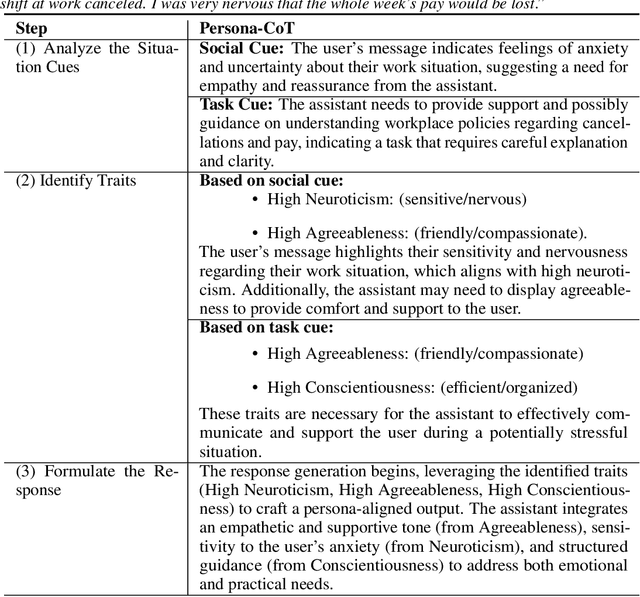
Abstract:Recent advancements in Large Language Models (LLMs) demonstrate remarkable capabilities across various fields. These developments have led to more direct communication between humans and LLMs in various situations, such as social companionship and psychological support. However, LLMs often exhibit limitations in emotional perception and social competence during real-world conversations. These limitations partly originate from their inability to adapt their communication style and emotional expression to different social and task contexts. In this work, we introduce PersonaFuse, a novel LLM post-training framework that enables LLMs to adapt and express different personalities for varying situations. Inspired by Trait Activation Theory and the Big Five personality model, PersonaFuse employs a Mixture-of-Expert architecture that combines persona adapters with a dynamic routing network, enabling contextual trait expression. Experimental results show that PersonaFuse substantially outperforms baseline models across multiple dimensions of social-emotional intelligence. Importantly, these gains are achieved without sacrificing general reasoning ability or model safety, which remain common limitations of direct prompting and supervised fine-tuning approaches. PersonaFuse also delivers consistent improvements in downstream human-centered applications, such as mental health counseling and review-based customer service. Finally, human preference evaluations against leading LLMs, including GPT-4o and DeepSeek, demonstrate that PersonaFuse achieves competitive response quality despite its comparatively smaller model size. These findings demonstrate that PersonaFuse~offers a theoretically grounded and practical approach for developing social-emotional enhanced LLMs, marking a significant advancement toward more human-centric AI systems.
Uncovering the Bigger Picture: Comprehensive Event Understanding Via Diverse News Retrieval
Aug 27, 2025Abstract:Access to diverse perspectives is essential for understanding real-world events, yet most news retrieval systems prioritize textual relevance, leading to redundant results and limited viewpoint exposure. We propose NEWSCOPE, a two-stage framework for diverse news retrieval that enhances event coverage by explicitly modeling semantic variation at the sentence level. The first stage retrieves topically relevant content using dense retrieval, while the second stage applies sentence-level clustering and diversity-aware re-ranking to surface complementary information. To evaluate retrieval diversity, we introduce three interpretable metrics, namely Average Pairwise Distance, Positive Cluster Coverage, and Information Density Ratio, and construct two paragraph-level benchmarks: LocalNews and DSGlobal. Experiments show that NEWSCOPE consistently outperforms strong baselines, achieving significantly higher diversity without compromising relevance. Our results demonstrate the effectiveness of fine-grained, interpretable modeling in mitigating redundancy and promoting comprehensive event understanding. The data and code are available at https://github.com/tangyixuan/NEWSCOPE.
HunyuanWorld 1.0: Generating Immersive, Explorable, and Interactive 3D Worlds from Words or Pixels
Jul 29, 2025



Abstract:Creating immersive and playable 3D worlds from texts or images remains a fundamental challenge in computer vision and graphics. Existing world generation approaches typically fall into two categories: video-based methods that offer rich diversity but lack 3D consistency and rendering efficiency, and 3D-based methods that provide geometric consistency but struggle with limited training data and memory-inefficient representations. To address these limitations, we present HunyuanWorld 1.0, a novel framework that combines the best of both worlds for generating immersive, explorable, and interactive 3D scenes from text and image conditions. Our approach features three key advantages: 1) 360{\deg} immersive experiences via panoramic world proxies; 2) mesh export capabilities for seamless compatibility with existing computer graphics pipelines; 3) disentangled object representations for augmented interactivity. The core of our framework is a semantically layered 3D mesh representation that leverages panoramic images as 360{\deg} world proxies for semantic-aware world decomposition and reconstruction, enabling the generation of diverse 3D worlds. Extensive experiments demonstrate that our method achieves state-of-the-art performance in generating coherent, explorable, and interactive 3D worlds while enabling versatile applications in virtual reality, physical simulation, game development, and interactive content creation.
Hunyuan3D 2.1: From Images to High-Fidelity 3D Assets with Production-Ready PBR Material
Jun 18, 2025Abstract:3D AI-generated content (AIGC) is a passionate field that has significantly accelerated the creation of 3D models in gaming, film, and design. Despite the development of several groundbreaking models that have revolutionized 3D generation, the field remains largely accessible only to researchers, developers, and designers due to the complexities involved in collecting, processing, and training 3D models. To address these challenges, we introduce Hunyuan3D 2.1 as a case study in this tutorial. This tutorial offers a comprehensive, step-by-step guide on processing 3D data, training a 3D generative model, and evaluating its performance using Hunyuan3D 2.1, an advanced system for producing high-resolution, textured 3D assets. The system comprises two core components: the Hunyuan3D-DiT for shape generation and the Hunyuan3D-Paint for texture synthesis. We will explore the entire workflow, including data preparation, model architecture, training strategies, evaluation metrics, and deployment. By the conclusion of this tutorial, you will have the knowledge to finetune or develop a robust 3D generative model suitable for applications in gaming, virtual reality, and industrial design.
MaterialMVP: Illumination-Invariant Material Generation via Multi-view PBR Diffusion
Mar 13, 2025Abstract:Physically-based rendering (PBR) has become a cornerstone in modern computer graphics, enabling realistic material representation and lighting interactions in 3D scenes. In this paper, we present MaterialMVP, a novel end-to-end model for generating PBR textures from 3D meshes and image prompts, addressing key challenges in multi-view material synthesis. Our approach leverages Reference Attention to extract and encode informative latent from the input reference images, enabling intuitive and controllable texture generation. We also introduce a Consistency-Regularized Training strategy to enforce stability across varying viewpoints and illumination conditions, ensuring illumination-invariant and geometrically consistent results. Additionally, we propose Dual-Channel Material Generation, which separately optimizes albedo and metallic-roughness (MR) textures while maintaining precise spatial alignment with the input images through Multi-Channel Aligned Attention. Learnable material embeddings are further integrated to capture the distinct properties of albedo and MR. Experimental results demonstrate that our model generates PBR textures with realistic behavior across diverse lighting scenarios, outperforming existing methods in both consistency and quality for scalable 3D asset creation.
Hunyuan3D 2.0: Scaling Diffusion Models for High Resolution Textured 3D Assets Generation
Jan 21, 2025



Abstract:We present Hunyuan3D 2.0, an advanced large-scale 3D synthesis system for generating high-resolution textured 3D assets. This system includes two foundation components: a large-scale shape generation model -- Hunyuan3D-DiT, and a large-scale texture synthesis model -- Hunyuan3D-Paint. The shape generative model, built on a scalable flow-based diffusion transformer, aims to create geometry that properly aligns with a given condition image, laying a solid foundation for downstream applications. The texture synthesis model, benefiting from strong geometric and diffusion priors, produces high-resolution and vibrant texture maps for either generated or hand-crafted meshes. Furthermore, we build Hunyuan3D-Studio -- a versatile, user-friendly production platform that simplifies the re-creation process of 3D assets. It allows both professional and amateur users to manipulate or even animate their meshes efficiently. We systematically evaluate our models, showing that Hunyuan3D 2.0 outperforms previous state-of-the-art models, including the open-source models and closed-source models in geometry details, condition alignment, texture quality, and etc. Hunyuan3D 2.0 is publicly released in order to fill the gaps in the open-source 3D community for large-scale foundation generative models. The code and pre-trained weights of our models are available at: https://github.com/Tencent/Hunyuan3D-2
A General Framework for Producing Interpretable Semantic Text Embeddings
Oct 04, 2024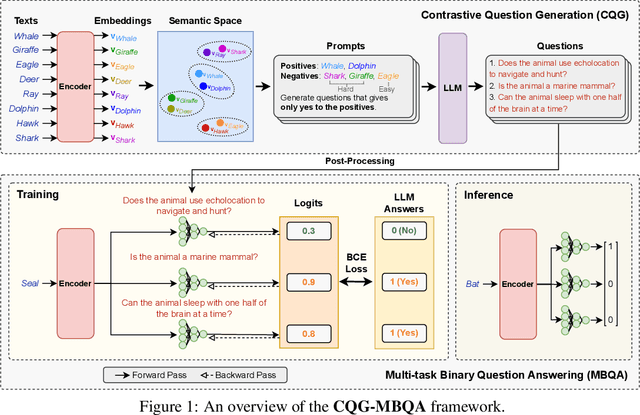

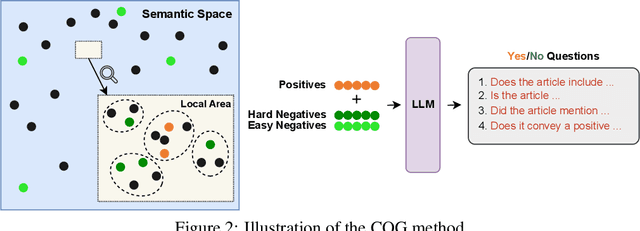
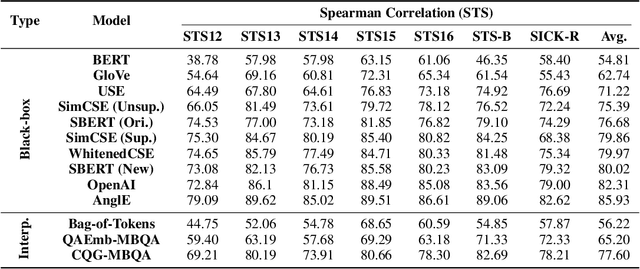
Abstract:Semantic text embedding is essential to many tasks in Natural Language Processing (NLP). While black-box models are capable of generating high-quality embeddings, their lack of interpretability limits their use in tasks that demand transparency. Recent approaches have improved interpretability by leveraging domain-expert-crafted or LLM-generated questions, but these methods rely heavily on expert input or well-prompt design, which restricts their generalizability and ability to generate discriminative questions across a wide range of tasks. To address these challenges, we introduce \algo{CQG-MBQA} (Contrastive Question Generation - Multi-task Binary Question Answering), a general framework for producing interpretable semantic text embeddings across diverse tasks. Our framework systematically generates highly discriminative, low cognitive load yes/no questions through the \algo{CQG} method and answers them efficiently with the \algo{MBQA} model, resulting in interpretable embeddings in a cost-effective manner. We validate the effectiveness and interpretability of \algo{CQG-MBQA} through extensive experiments and ablation studies, demonstrating that it delivers embedding quality comparable to many advanced black-box models while maintaining inherently interpretability. Additionally, \algo{CQG-MBQA} outperforms other interpretable text embedding methods across various downstream tasks.
Do We Need Domain-Specific Embedding Models? An Empirical Investigation
Sep 27, 2024Abstract:Embedding models play a crucial role in representing and retrieving information across various NLP applications. Recent advancements in Large Language Models (LLMs) have further enhanced the performance of embedding models, which are trained on massive amounts of text covering almost every domain. These models are often benchmarked on general-purpose datasets like Massive Text Embedding Benchmark (MTEB), where they demonstrate superior performance. However, a critical question arises: Is the development of domain-specific embedding models necessary when general-purpose models are trained on vast corpora that already include specialized domain texts? In this paper, we empirically investigate this question, choosing the finance domain as an example. We introduce the Finance Massive Text Embedding Benchmark (FinMTEB), a counterpart to MTEB that consists of financial domain-specific text datasets. We evaluate the performance of seven state-of-the-art embedding models on FinMTEB and observe a significant performance drop compared to their performance on MTEB. To account for the possibility that this drop is driven by FinMTEB's higher complexity, we propose four measures to quantify dataset complexity and control for this factor in our analysis. Our analysis provides compelling evidence that state-of-the-art embedding models struggle to capture domain-specific linguistic and semantic patterns, even when trained on large general-purpose corpora. This study sheds light on the necessity of developing domain-specific embedding models in the LLM era, offering valuable insights for researchers and practitioners.
Pooling And Attention: What Are Effective Designs For LLm-Based Embedding Models?
Sep 04, 2024Abstract:The significant advancements of Large Language Models (LLMs) in generative tasks have led to a growing body of work exploring LLM-based embedding models. While these models, employing different pooling and attention strategies, have achieved state-of-the-art performance on public embedding benchmarks, questions still arise about what constitutes an effective design for LLM-based embedding models. However, these models are often trained on different datasets, using different LLM base models or training settings. Moreover, evaluations on public embedding benchmarks often fail to report statistical significance, making it difficult to determine which designs truly contribute to final performance. This complicates the process for practitioners seeking optimal training recipes for LLM-based embedding models. In this study, we conduct a large-scale experiment by training a series of LLM-based embedding models using the same training data and base model but differing in their pooling and attention strategies. The results show that there is no one-size-fits-all solution: while bidirectional attention and an additional trainable pooling layer outperform in text similarity and information retrieval tasks, they do not significantly surpass simpler designs like EOS-last token pooling and default causal attention in clustering and classification tasks. Furthermore, we propose a new pooling strategy, Multi-Layers Trainable Pooling, which transforms the outputs of all hidden layers, rather than just the last layer, using a cross-attention network. This method proves to be statistically superior in text similarity and retrieval tasks compared to existing pooling methods. Overall, this paper sheds light on effective training strategies for LLM-based embedding models.
 Add to Chrome
Add to Chrome Add to Firefox
Add to Firefox Add to Edge
Add to Edge